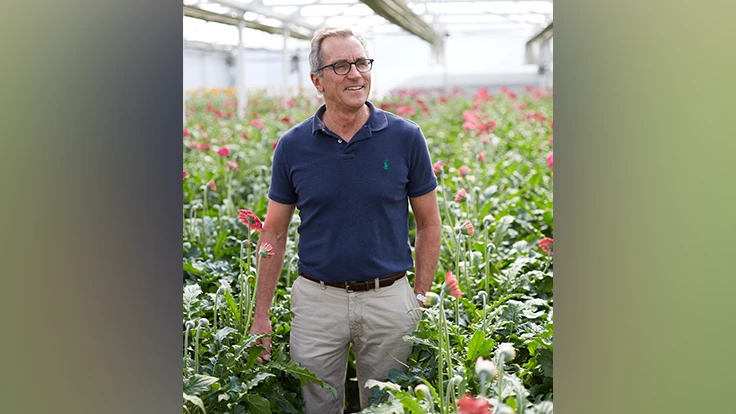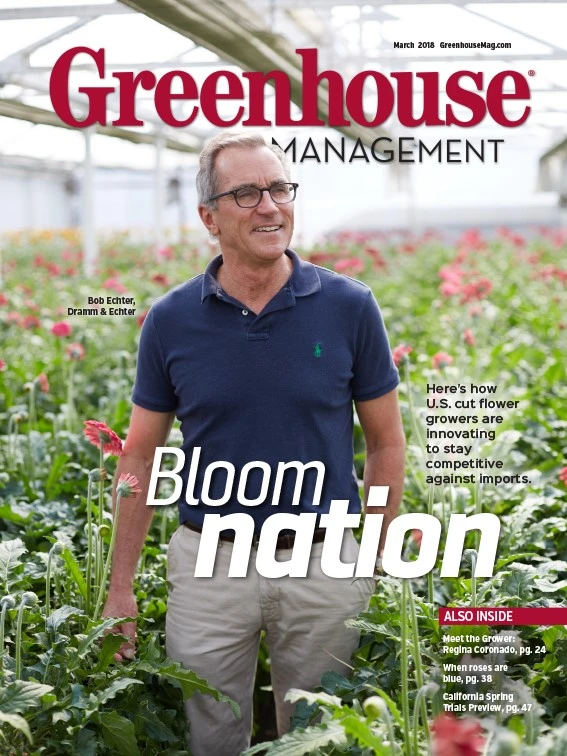


Bob Echter doesn’t have to look far to see the changing tides of the cut flower industry. As second-generation owner of Dramm & Echter, he’s seen market shifts redefine his family’s flower farm over time. To stay competitive in an industry rife with labor constraints, changing customer demands and low-cost imports, growers like Echter must keep innovating to survive.
Echter’s family has evolved through decades of industry changes since his grandfather emigrated from Germany to run a small flower shop in Iowa. In the ’50s, the second Echter generation moved to Denver, which had become a prominent region for growing carnations. Then in the ’60s, flower growers like the Echters flocked to California as air freight and truck lines enabled nationwide transport from the coast’s ideal growing climates.
Bob’s father partnered with another family of flower growers in 1972 to establish Dramm & Echter. By the time Bob joined the family business in 1982, the regional flower market had begun to shift drastically.
_fmt.png)
“The carnation and chrysanthemum markets were moving to South America,” Echter says. “They had climatic advantages in addition to labor savings. Suddenly, successful farms were opening up down there, so we saw an erosion of the [U.S.] marketplace on those products.”
In 1991, the U.S. suspended import duties on flowers from South American countries including Colombia and Ecuador, in efforts to reduce drug trafficking. By 2003, the U.S. imported more flowers from Colombia than it produced domestically. Today, roughly 80 percent of flowers sold in the U.S. are imported, according to the California Cut Flower Commission (CCFC).
“It’s the main challenge [U.S. flower] farms must struggle through to compete,” says Kasey Cronquist, CEO and ambassador of CCFC, the state agency that represents California’s 200-plus flower farms. “Having essentially lost all of our carnation, chrysanthemum and rose production to South America, the impact of imports on U.S. production has been dramatic.”
The growers that keep growing are the ones that have evolved. Here’s how they’re staying competitive.

Diversified blooms
“The best strategy is to differentiate your product line from what importers can bring in,” Cronquist says. So when South American farms began to dominate certain crops, domestic growers diversified into other varieties.
For example, South America’s long crop cycles produce large hybrid tea roses — so it’s no surprise that over 99 percent of roses sold in the U.S. are imported. The shift forced Dramm & Echter to transition away from hybrid tea roses into spray roses and focus on more competitive crops that don’t travel as well, like Gerbera daisies.
At one point, Dramm & Echter grew 30 flower varieties, but today, production is concentrated on just three types of flowers: spray roses, oriental lilies and Gerbera daisies. The other varieties they supply are brokered or consigned from other growers, both domestic and abroad.
Outside of Minneapolis, Len Busch Roses felt the same impact from imports on its namesake crop. “We’re still very strong in roses; we just don’t grow them,” says CEO Patrick Busch, whose father founded the flower farm in 1965. “The import market has forced us to diversify, and that ends up being a good thing over time.”
Len Busch Roses, the only major cut flower grower in the Central U.S., according to its website, produces 7 million cut stems and potted flowers annually. Len Busch Roses grows about 40 percent of what it sells (including alstroemeria, Gerbera daisies, lilies, spray roses, snapdragons and tulips), and imports roses, carnations, poms, orchids and other tropicals.
“We can’t grow a complete line-up,” Busch says. “We’d be missing the opportunity of a lot of great imported flowers and putting more demand on ourselves than we have capacity for.”

Sustainable survival
American growers may struggle to compete with the price of imports, but they can add value in other ways. For Len Busch Roses, sustainability initiatives generate efficiency and profitability against steep competition.
For example, Busch collects 600 semi-loads of local tree-trimming waste annually, which is burned in environmentally friendly biomass boilers to heat all 15 acres of greenhouses. This system is critical to surviving Minnesota’s cold winters. “If we didn’t mitigate the cost of heat for the greenhouses, we wouldn’t be profitable,” Busch says.
Dramm & Echter is equally keen on sustainability. There, boiler exhaust is collected and injected back into the roses, which improves growth, quality and productivity, Echter says. They also recycle water from their hydroponic growing system using sterilization and reverse osmosis.
In place of chemical pest controls, Dramm & Echter uses beneficial insects. Swirskii mites control harmful cyclamen mites and broad mites, predatory persimilis control spider mites, and parasitic Diglyphus wasps control pesky leafminers.
Dramm & Echter’s sustainability efforts are certified by California’s BloomCheck program, which provides third-party assurance that flowers are grown using best practices to protect the environment.
Both Len Busch Roses and Dramm & Echter also employ “lean” methodology to eliminate waste and increase efficiencies. Echter hired consultants to identify small changes in his growing operation that could streamline production and improve quality. The consultants suggested adjustments — such as to the nutrient balance of the rose fertilizer and the temperature in the Gerbera greenhouse — that helped Echter improve productivity by 25 percent.
“Changing our temperature regimes improved Gerbera production noticeably,” Echter says. “It also lessened our fuel use, so we’re growing cooler and getting higher productivity.”

Photo courtesy of Kasey Cronquist
Local demand
The biggest trend Busch sees in the cut flower industry is rising demand for locally grown products.
“Florists have always valued local fresh quality, but we’re finding that the mass markets are showing a much stronger interest in it,” says Busch, who supplies retail florists and supermarkets throughout a 200-mile radius around Minneapolis. “Local is meaningful to floral buyers because it’s meaningful to their retail customers.”
To distinguish flowers grown at Len Busch Roses from imported product, the company recently created a new retail brand, Busch Flower Farm. Locally grown flowers will be branded with this name in certain retail applications, while imported flowers will be in plain, non-branded sleeves.
Busch has a license to use Minnesota Grown labeling on its domestic flowers, in addition to Certified American Grown, a national program launched in 2014 to market and promote domestic flowers. Dramm & Echter also adopted American Grown labeling, after marketing its flowers as locally grown for decades.
The catalyst for the Certified American Grown program was a consumer preference study commissioned by the CCFC several years ago. “It showed that 74 percent of people had no idea where flowers come from, yet 58 percent would prefer to buy American-grown flowers if given the choice,” says Cronquist, who administers the program. “My advice to farmers is: Make sure you’ve got an origin-based label on your product that will differentiate you from imports. It helps consumers feel good about where they’re buying from.”
Author Debra Prinzing says consumer interest in local blooms — or “slow flowers,” as she coined the movement — is fueled by an increasing awareness of where food comes from. Once people started raving about local produce and farm-to-table restaurants, it was only a matter of time before they expected the same freshness in flowers.
Prinzing sees opportunity for growers to take advantage of this shift by hosting greenhouse tours and other “floral tourism” events that showcase locally grown flowers — like American Grown Flowers has been doing with its Field to Vase Dinner Tour, featuring farm-to-table meals hosted by flower farms around the country.
“Getting people to sit amongst rows of Gerbera daisies has such an impact on their understanding of flower production,” says Prinzing, founder and creative director of Slow Flowers (slowflowers.com), an online directory of florists, event planners and growers committed to domestic blooms. “The purpose of [these events] is to get people onto farms, create an experience and connect them with people who grow flowers, so they understand how important it is.”

Photo courtesy of Debra Prinzing
Industry outlook
Despite the challenges facing the cut flower industry, American growers are hopeful about the opportunities ahead.
Prinzing is encouraged by the mainstream focus on local, seasonal flowers — from her Instagram feed to the New York Fashion Week runway. But she knows the progress of the “slow flower” movement will be just that: slow.
“It takes a while to move this giant mass market machine, but it’s happening,” she says. “There’s noticeable rebound taking place, but we’re talking fractions of percentage points from 80 percent imports to 20 percent domestic production. If we get to 70/30, I could consider that we won the battle, because imports are not going to go away.”
The last USDA Census of Agriculture report, which was published five years ago, showed 16 percent growth in the number of U.S. cut flower farms between 2007 and 2012. The 2017 census won’t be reported until April 2018, but Prinzing predicts more than 16 percent growth.
Last year — thanks in part to the efforts of Cronquist, Prinzing and other supporters of domestic flower production — Congress declared July as American Grown Flowers month to highlight fresh U.S. blooms in a crowded global marketplace.
“Our challenge will continue to be remaining competitive against imports — whether that’s in terms of meeting price points, finding sales opportunities with mass marketers or maintaining profitability,” Cronquist says. “But the industry has some momentum [surrounding] this consumer-driven interest for supporting American flower farmers, so we see a lot of opportunity.”

Explore the March 2018 Issue
Check out more from this issue and find your next story to read.
Latest from Greenhouse Management
- Anthura acquires Bromelia assets from Corn. Bak in Netherlands
- Top 10 stories for National Poinsettia Day
- Langendoen Mechanical hosts open house to showcase new greenhouse build
- Conor Foy joins EHR's national sales team
- Pantone announces its 2026 Color of the Year
- Syngenta granted federal registration for Trefinti nematicide/fungicide in ornamental market
- A legacy of influence
- HILA 2025 video highlights: John Gaydos of Proven Winners





